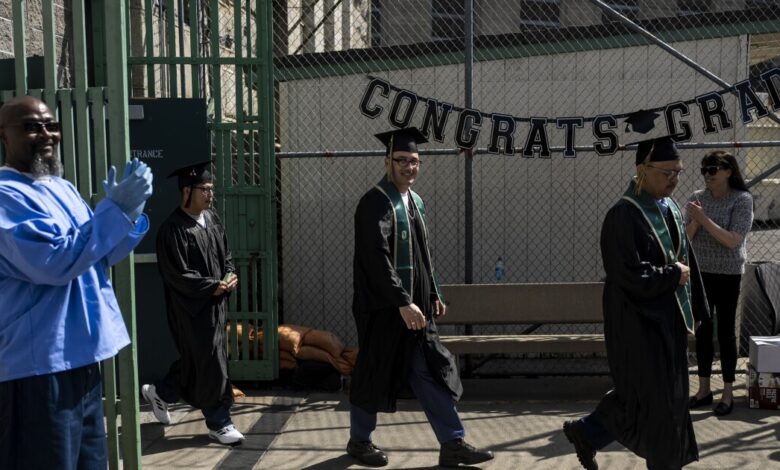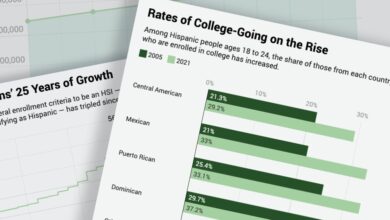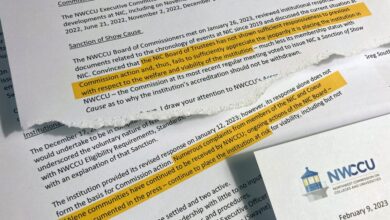Prison Education Just Got a Whole Lot Bigger. Here Are 3 Key Questions About What’s Next.

The U.S. government reinstated access to federal financial aid for hundreds of thousands of incarcerated students over the weekend as a decades-old ban was officially lifted, opening the door to a more robust future for prison education.
Students incarcerated in federal or state penal institutions were ineligible for Pell Grants, the primary federal aid program for low-income students, for nearly 30 years. That ban can be traced to the 1994 crime bill, which caused most prison higher-ed programs to shutter.
On Saturday, more than 760,000 incarcerated students became eligible for Pell Grants, according to the U.S. Department of Education, and applications began to be accepted on Monday.
Jason Bell, director of San Francisco State University’s Project Rebound, a program focused on supporting formerly incarcerated students across the California State University system, called the restoration of Pell eligibility “beautiful.”
Bell, who was a student in Project Rebound after he was released from incarceration, said the prior ban on eligibility had made it much harder to pursue a degree. “It was really difficult to get any higher education behind the wall,” Bell said. “It was a much rougher time for folks living in the incarceration system during that period.”
In recent years, a pilot program called Second Chance Pell has tested the reinstatement of eligibility for the grants. Programs like the Transforming Outcomes Project, a four-year-degree program administered through California’s Folsom State Prison and Mule Creek State Prison, worked with incarcerated people who received the grants.
David Zuckerman, interim director of the project, which is operated by California State University at Sacramento, said getting the initial group of incarcerated students into the financial-aid system required adaptation. (More than 40,000 students now benefit from Second Chance Pell, according to federal officials.)
“Pell was not designed for incarcerated students,” he said. “When it works, it’s phenomenal because it allows an indigent, incarcerated person to get a university education, and that’s fantastic.”
As Pell eligibility opens up more opportunities for incarcerated students, The Chronicle spoke with several experts about three key questions facing colleges as they try to move into prison education.
How will the students get advising and other academic support?
Attending college comes with a fair share of bureaucratic snafus. While students on campus can pop into an adviser’s office, incarcerated students don’t have that option. They have little to no internet access and little money.
Zuckerman said employing counselors just for incarcerated students, available either online or inside a prison, can make the difference.
“You need someone in financial aid who’s dedicated to these programs and educated in the ins and outs of prison education,” Zuckerman said. “And not just in terms of policy, but in terms of day-to-day practice that you’re going to run up against.”
Incarcerated students often don’t have access to documents or to means of payment that staff members might need to remove a financial-aid hold, for example. So having people on staff who can help navigate course schedules, order transcripts, or inquire about financial-aid holds can be key.
Margaret diZerega, managing director of initiatives at the Vera Institute of Justice, a nonprofit advocacy group focused on decriminalization, agreed.
“It’s important,” she said, “that colleges think about the prison program like they would any other satellite campus.”
How will students complete their work with limited internet access?
At Sacramento State, students in Zuckerman’s program, which is known as Topss, can take upper-division communication-studies classes. They’re identical to the ones taught on campus, he said, but the incarcerated students have only a narrow window of time for academics.
The students attend class for three hours after their daily work shifts, but while in their cells, they have no Wi-Fi. They are given laptops and can use Canvas, a course-management program for students to submit assignments online. But because of their curfew, they have to “cram everything into a few hours.”
In spite of those limitations, the instructor in the class last fall saw his incarcerated students score an average of 20 points higher than the on-campus students, Zuckerman said.
“They’re blowing everybody aside,” he said. “They’re zooming past everybody, and it’s not because they’re in prison and all they do is sit around and study. That’s not the case. Most of the Topss students work 40 hours a week inside the prisons.”
How will more such partnerships start?
Effectively educating incarcerated students requires more staff time, and colleges might look for the most efficient way to provide it.
One important idea, Zuckerman said, was designating a staff member to help those students in the registrar’s office.
DiZerega added that college staff members should also tour a prison in advance to talk to prospective students to lay a foundation for a program. That includes conversations about how a course is to be taught, online or in person; the type of technology offered to students; and their access to library resources and academic journals.
“Having those kinds of upfront conversations can be helpful to set those expectations and figure out where the areas are that [we] need to work through as a corrections department and college as they enter a partnership,” diZerega said.
And while access to Pell Grants will provide more opportunities to create prison-education programs, Bell said colleges and universities need to have good intentions.
“Some of these folks are chasing dollars, and they have no intention of welcoming folks to their campuses,” Bell said. “That bothers me.” If that’s a college’s intention, he continued, “I think we’re failing in that sense.”
Colleges should minimize bureaucratic obstacles, Bell said, and hiring formerly incarcerated people into programs can help do that.
“When we have these discussions, having formerly incarcerated folks with that experience and hiring between the wall as well as on these college campuses — invite them to those discussions,” he said. “That is the key of learning from the pitfalls, as well as the successes, and that’s how we make it happen correctly.”
Source link






